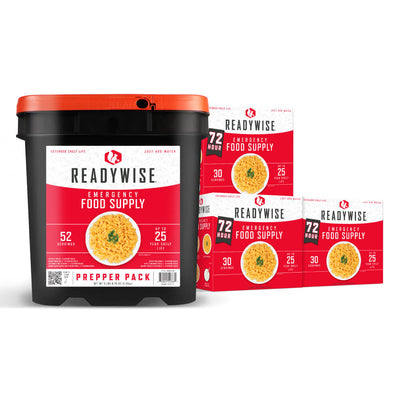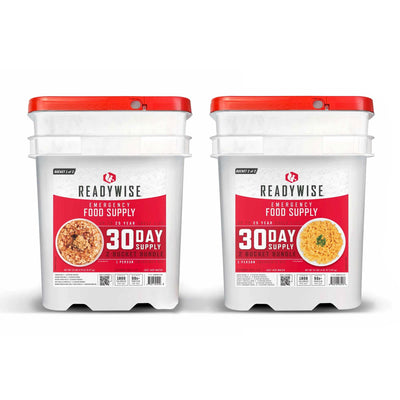If you ever find yourself in an emergency situation and need to evacuate, you’ll need a bug-out-bag (BOB) to survive. A BOB should help you survive for up to 72 hours, so it’s important to pack it with any bug-out bag essentials you might need while out in the wild or making your way to safety.
Some of the first things you’ll probably think of packing are water, shelter, some rope, a first-aid kit, a survival knife and, of course, food for bug-out bag. It is not without reason that some of history’s greatest military leaders — including Napoleon — have stressed the importance of food in situations of high physical and mental demand. In a life-or-death situation, the right food can keep you sharp and energized enough to get to your desired destination.
Food Considerations
Deciding what food to bring can be difficult. You need food that is high in nutrients and calories, easy to prepare and has a long shelf life. Your bug-out bag bag should also only weigh up to 15 percent of your body weight, so your food must be light and compact.
Remember that you also don’t want to spend a lot of time cooking. You’re looking to get to a certain destination as quickly as possible, so cooking tasty and elaborate meals might not be an option. This does not mean you should be eating food that tastes like cardboard, but it does mean you should look for foods that are easy to prepare.
Consider that you might also be able to find food along the way. Pack a fishing kit and a quality tactical knife to hunt and prepare any food you may find.
How Much Food Should I Bring?
It may not be realistic to pack three whole meals for three days unless you have a vehicle. Plan for the worst-case scenario and assume you’ll be on foot.
Your meals should be light, and it’s probably best to pack snacks as opposed to big meals. Ideally, you should have a decent-sized breakfast and dinner, with a few portable snacks along the way. This allows you to stay full without having to stop along the way to eat. If you followed this plan, you’d be taking six meals and snacks for each person, but it’s best to bring a couple extra meals just in case. In total, you should be aiming for eight meals plus snacks. Make sure you’re packing at least 2,000 calories per person per day.
What Food Should I Bring?
To recap, the food you pack should be nutritious, shelf stable, calorie dense, easy to cook and lightweight. The food you bring doesn’t have to be completely tasteless either. While these requirements may sound difficult to fulfill, many of the foods in your pantry right now probably fit this description.
Calorie-Dense Foods
Nuts, dried fruit and peanut butter are staples you probably already have in your house. Small pouches of peanut butter are ideal because they’re high in protein and calories. Nuts and dried fruits are similarly high in energy and perfect for snacking on while you walk.
Dehydrated Foods
“Just add water” foods are ideal to pack in your bug-out-bag. Dehydrated and freeze-dried foods, as well as pouches of mashed potatoes, fit into this category. This kind of emergency food can be nutritious, and their high carbohydrate content should keep you energized. Instant oatmeal, for example, is easy to prepare and nutritious — and also quite healthy. You’ll be using up some of the drinking water, however, so make sure you pack enough of it for both food prep and direct consumption.
Canned Foods
Canned food — especially canned meat such as Spam or tuna — are also good to pack. They’re durable and provide the protein you need in a high-stress emergency situation. You can use your survival knife to open any cans you bring with you or to chop up your food.
Dry Goods
Bags of dry pasta and rice are also good foods to bring along. A couple of pounds of pasta or rice can go a long way and keep you satisfied for a long time. Even ramen, otherwise thought of as something you only eat as a college student, can be a good option in a survival situation. The only thing you must keep in mind is that you need to boil a good amount of water to cook your pasta, rice or ramen. This means you either need to bring more water with you or invest in a good survival water filter.
Meal Replacement Bars
Meal replacement bars can also be a good idea that will save space in your bag. These can make a good snack along the way or even a satisfying meal if you eat a few of them. The best brands produce bars that provide many of the nutrients and vitamins you might be lacking in the rest of the food you pack.
Coffee or Energy Drinks
While not explicitly food, caffeine can come in handy in certain situations. The caffeine boost can help you keep moving when you feel tired.
If you put sugar in your coffee, it can also give you a small hit of energy. If you don’t have space in your bag or don’t think it’s a priority, you can leave it out. Otherwise, packing a few small pouches of instant coffee can be helpful.
Candy
Finally, the last item you may want to consider is chocolate or a candy bar. Much like sugar and coffee, chocolate can give you the sugar rush you need for a quick boost of energy. It can also break the monotony of consuming somewhat bland or repetitive meals during your trip and is calorie-dense enough to help you sustain yourself.
How to Store and Pack Your Bug-Out-Bag Food
When it comes to packing your food, how you store it is just as important as what you pack. You’ll want to make sure everything is sealed tightly and protected from the elements.
Use resealable, waterproof bags to keep moisture out and preserve the freshness of your food. Vacuum-sealing is another great option for keeping food compact and protected. Consider using a dry bag for extra protection, especially if you're heading into wetter environments. If you're packing dehydrated or freeze-dried foods, make sure the pouches are intact and undamaged.
Make sure everything is easy to access, too. In an emergency, you won’t have time to dig through your bag. Organize your food in smaller sections or zip-lock bags so you can grab exactly what you need without fumbling around.
Additional Tips for Bug-Out-Bag Food
Don’t Forget Your Spoon!
While this may seem like a small thing, not having the proper utensils can make eating your food much harder. Pack a lightweight spoon or fork, or even a multi-tool with eating utensils attached.
Opt for Ready-to-Eat Meals (MREs)
While they’re heavier than some other food options, MREs (Meals Ready to Eat) are a solid choice if you want a one-stop solution for a meal. They’re designed to provide balanced nutrition and are easy to prepare in any situation.
Rotate Your Stock
It's important to periodically check your food stock and rotate it so nothing goes past its expiration date. Keep track of what you have, and replace anything that’s getting close to its shelf life.
Pack for Special Dietary Needs
If you have any dietary restrictions or allergies, be sure to pack food that fits your needs. For example, gluten-free or vegan options are available for most types of survival food.
Stay Energized with Well-Planned Bug-Out-Bag Food
The bottom line when it comes to packing food is to make sure you can carry it and cook it when you’re on the move. It is also critical you pack enough for a little over three days. However, while this may sound difficult, you already have many of the potential foods for your bug-out-bag at your disposal. Get creative and pack foods you genuinely like — and don’t forget to take the tools and weapons you’ll need, such as a sturdy survival knife.

















































































I’m impressed with the level of professionalism and care this site demonstrates. The information provided on DMT, LSD, and Ayahuasca is thoughtful and well-presented, and the delivery process was smooth and timely. It’s clear that attention to detail and customer satisfaction are priorities here — much appreciated. dmtbloom.com